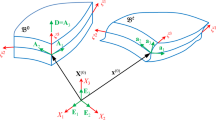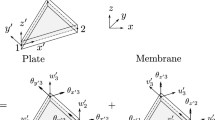Abstract
A simple non-linear stress resultant four node shell finite element is presented. The underlying shell theory is developed from the three dimensional continuum theory via standard assumptions on the displacement field. A model for thin shells is obtained by approximating terms describing the shell geometry. In this work the rotation of the shell director is parameterized by the two Euler angles, although other approaches can be easily accomodated. A procedure is provided to extend the presented approach by including the through-thickness variable material properties. These may include a general non-linear elastic material with varied degree of orthotropy, which is typical for fibre reinforced composites. Thus a simple and efficient model suitable for analysis of multilayered composite shells is attained. Shell kinematics is consistently linearized, leading to the Newton-Raphson numerical procedure, which preserves quadratic rate of asymptotic convergence. A range of linear and non-linear tests is provided and compared with available solutions to illustrate the approach.
Similar content being viewed by others
References
Andelfinger, U.; Ramm, E. 1993: EAS-elements for two-dimensional, three-dimensional, plate and shell structures and their equivalence to HR-elements. Int. J. Numer. Meth. Engng. 36: 1311–1337
Basar, Y.; Ding, Y. 1990: Theory and finite-element formulation for shell structures undergoing finite rotations, In: Voyiadjis, G. Z.; Karamanlidis, D. (eds.): Advances in the Theory of Plates and Shells. Elsevier Science Publ.
Bathe, K.-J.; Dvorkin, E. N. 1985: A four-node plate bending element based on Mindlin/Reissner plate theory and a mixed formulation. Int. J. Numer. Meth. Engng. 21: 367–383
Brank, B.; Perić, D.; Damjanić, F. B. 1993: A nonlinear four node shell element with explicit integration and elementary rotations. In: Kussmaul, K. F. (ed.): Proc. Trans. of the 12th Int. Conf. SMIRT, Vol. B, 153–158, Elsevier Science Publ.
Büchter, N.; Ramm, E. 1992: Shell theory versus degeneration-a comparison in large rotation finite element analysis. Int. J. Numer. Meth. Engng. 34: 39–59
Crisfield, M. A. 1991: Non-linear Finite Element Analysis of Solids and Structures, Vol. 1 Chichester: John Wiley
Dvorkin, E. N.; Bathe, K.-J. 1984: A continuum mechanics based four-node shell element for general non-linear analysis. Eng. Comput. 1: 77–88
Figueiras, J. A.; Owen, D. R. J. 1984: Analysis of elasto-plastic and geometrically nonlinear anisotropic plates and shells. In: Hinton, E.; Owen, D. R. J. (eds.): Finite Element Software for Plates and Shells, 235–326, Swansea: Pineridge Press
Gebhardt, H.; Schweizerhof, K. 1993: Interpolation of curved shell geometries by low order finite elements-errors and modifications. Int. J. Num. Meth. Engng. 36: 287–302
Green, A. E.; Zerna, W. 1968: Theoretical Elasticity. 2nd Ed. Oxford University Press
Laschet, G.; Jeusette, J.-P. 1990: Postbuckling finite element analysis of composite panels. Compos. Struct. 14: 35–48
Lindberg, G. M.; Olson, M. D.; Cowper, G. R. 1969: New developments in the finite element analysis of shells. National Research Council of Canada, Quarterly Bulletin of the Division of Mechanical Engineering and National Aeronautical Establishment, 4: 1–38
Matthews, F. L.; Rawlings, R. D. 1994: Composite Materials: Engineering and Science. London: Chapman and Hall
Naghdi, P. M. 1972: The theory of shells. In: Flüge, S. (ed.): Handbuch der Physik, Vol. VI/2, Springer-Verlag
Parisch, H. 1991: An investigation of a finite rotation four node assumed strain element. Int. J. Num. Meth. Engng. 31: 127–150
Perić, D.; Owen, D. R. J. 1991: The Morley thin shell finite element for large deformations problems: simplicity versus sophistication. In: Bićanić, N. (ed.): Proc. Int. Conf. on Nonlinear Engineering Computations, 121–142, Swansea: Pineridge Press
Pian, T. H. H.; Sumihara, K. 1984: Rational approach for assumed stress finite elements. Int. J. Num. Meth. Engng. 20: 1685–1695
Ramm, E.; Matzenmiller, A. 1986: Large deformation shell analysis based on the degeneration concept. In: Hughes, T. J. R.; Hinton, E. (eds.): Finite Element Methods for Plate and Shell Structures, 365–393, Swansea: Pineridge Press
Saigal, S.; Kapania, R.; Yang, Y. 1986: Geometrically nonlinear finite element analysis of imperfect laminated shells. J. Composite Mater. 20: 197–214
Sansour, C.; Bufler, H. 1992: An exact finite rotation shell theory, its mixed variational formulation and its finite element implementation. Int. J. Num. Meth. Engng. 34: 73–115
Simo, J. C.; Fox, D. D. 1989a: On a stress resultant geometrically exact shell model. Part I: Formulation and optimal parametrization. Comp. Meth. Appl. Mech. Engng. 72: 267–304
Simo, J. C.; Fox, D. D.; Rifai, M. S. 1989b: On a stress resultant geometrically exact shell model. Part II: The linear theory; Computational aspects. Comp. Meth. Appl. Mech. Engng. 73: 53–92
Simo, J. C.; Fox, D. D.; Rifai, M. S. 1990: On a stress resultant geometrically exact shell model. Part III: Computational aspects of the nonlinear theory. Comp. Meth. Appl. Mech. Engng. 79: 21–70
Simo, J. C.; Hughes, T. J. R. 1986: On the variational foundations of assumed strain methods. J. Appl. Mech. 53: 51–54
Stander, N.; Matzenmiller, A.; Ramm, E. 1989: An assessment of assumed strain methods in finite rotation shell analysis. Eng. Comput. 6: 57–66
Stanley, G. 1985: Continuum Based Shell Elements. Ph.D. Dissertation, Applied Mechanics Division, Stanford: Stanford University
Timoshenko, S.; Woinowsky-Krieger, S. 1959: Theory of Plates and Shells, 2nd edition, New York: McGraw-Hill
Wriggers, P.; Gruttmann, F. 1993: Thin shells with finite rotations formulated in Biot stresses: Theory and finite element formulation. Int. J. Numer. Meth. Engng. 36: 2049–2071
Wriggers, P.; Simo, J. C. 1990: A general procedure for the direct computation of turning and bifurcation points. Int. J. Numer. Meth. Engng. 30: 155–176
Author information
Authors and Affiliations
Additional information
Communicated by K. J. Bathe, 18 May 1995
The work has been financially supported from Joint Europian Project TEMPUS-ACEM No. 2246-91 and the Ministry of Science and Technology of Slovenia.
Rights and permissions
About this article
Cite this article
Brank, B., Damjanić, F.B. & Perić, D. On implementation of a nonlinear four node shell finite element for thin multilayered elastic shells. Computational Mechanics 16, 341–359 (1995). https://doi.org/10.1007/BF00350723
Issue Date:
DOI: https://doi.org/10.1007/BF00350723




